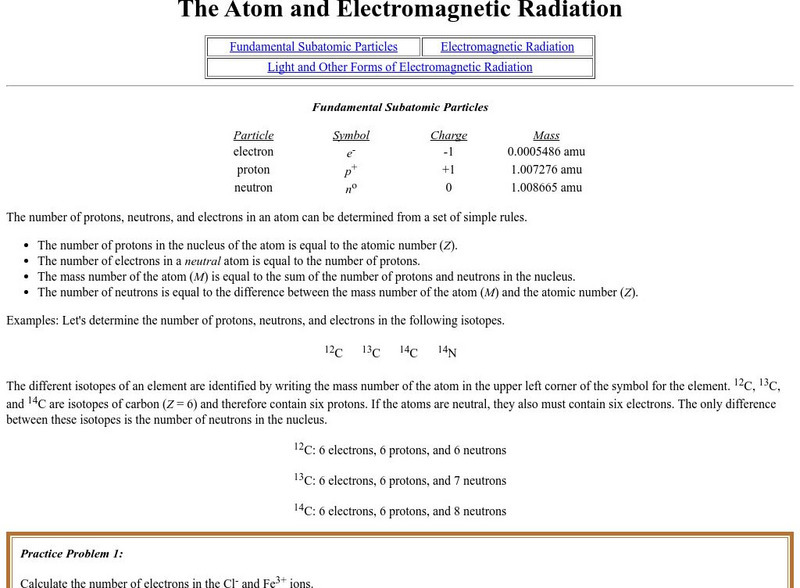Sophia Learning
Sophia: Interpreting Electron Configurations: Lesson 3
This lesson will demonstrate how to identify an element and state the number of valence electrons given its electron configuration. It is 3 of 3 in the series titled "Interpreting Electron Configurations."
Sophia Learning
Sophia: Identifying Valence Electrons
A slide show presentation which demonstrates how to identify the number of valence electrons an element has based on its location on the periodic table.
Sophia Learning
Sophia: Valence Electrons and Core Electrons
Through a series of slide show presentations and a video lesson, strengthen your understanding of valence electrons. [2:46]
Purdue University
Purdue University: Fundamental Subatomic Particles
At this site from the Purdue University, the elementary subatomic particles are described and electromagnetic radiation is detailed. Includes learning exercises and answers.
Science Struck
Science Struck: Noble Gas Configuration
Provides the configuration for each of the six noble gases and explains how to write noble gas configurations. Also explains what pseudo-noble gas configuration is.
Oklahoma State University
Oklahoma State University: Ionization Energy Trends
Site that discusses trends in ionization energy across and down the periodic table. Apparent contradictions are explained using electron configurations.
Chiral Publishing
Chiral Publishing: An Introduction to Chemistry: Abbreviated Electron Configurations
Test your electron-configuration skills in this animated exercise. Practice writing the abbreviated configurations for some of the common elements on the periodic table.
Royal Society of Chemistry
Royal Society of Chemistry: Periodic Table
An interactive Periodic Table of the Elements that displays specific properties of each element
Alabama Learning Exchange
Alex: "Electron" Ic Battleship
The students will play a game of Battleship on the Periodic Table to review electron configuration of the elements.This lesson plan was created as a result of the Girls Engaged in Math and Science University, GEMS-U Project.
Concord Consortium
Concord Consortium: Structure of an Atom
Observe the probable location of electrons around an atom. Trace the electrons over time to draw conclusions about where electrons are likely to be found around an atom's nucleus. How does the trace pattern relate to the electron cloud...
Chiral Publishing
Chiral Publishing: An Introduction to Chemistry: Abbreviated Electron Configurations Help
This section from the online textbook "An Introduction to Chemistry" provides helpful hints to writing abbreviated electron configurations. Also learn how to look up the atom's outer shell electrons.
Chiral Publishing
Chiral Publishing: An Introduction to Chemistry: Elements With Unexpected Electron Configurations
This section of the online textbook "An Introduction to Chemistry", shows the unexpected electron configurations of six elements. A chart compares their predicted configurations with their actual configurations. Also find links to...
University of Maryland
Um: Quantum Mechanics of One and Two Electron Atoms
An explanation of Hund's rule and how to apply it to quantum mechanics. A mathematical-based explanation.
University of Colorado
University of Colorado: Physics 2000: The Pauli Exclusion Principle
This site from the University of Colorado at Boulder has great information on the Pauli Exclusion Principle. Pictures are provided along with links to additional information. The information provided is not in-depth and it is...
University of Colorado
University of Colorado: Physics 2000: Periodic Table: Valences and the Periodic Table
The periodic table was laid out using valences or the electrons in the outermost shell.
University of Colorado
University of Colorado: Physics 2000: Elements as Atoms: Spin
A basic explanation of spin and how it relates to electrons and quantum numbers.
Other
Chemtopics: Atomic Orbitals & Electron Configurations [Pdf]
Solutions to the Schrodinger wave equation give four types of atomic orbitals. Explanation of how quantum numbers specify these orbitals.
Other
Web Chem: Bonding: Valence and Core Electrons
This site from WebChem contains information on the subject of bonding with an emphasis on valence and core electrons.
University of Colorado
University of Colorado: Physics 2000: Origin of the Periodic Table: Valence Electrons
Valence electrons are defined in terms of electron configuration.
Sophia Learning
Sophia: Writing Electron Configurations: Lesson 3
This lesson will demonstrate how to write the electron configurations for any element given its location on the periodic table. It is 3 of 3 in the series titled "Writing Electron Configurations."
Science Struck
Science Struck: Ground State vs. Excited State of an Atom
Explains what Bohr's model of the atom is, the characteristics of the ground and excited states of an atom, and the electron configuration for each in the example of Phosphorus.
Other
Chemtopics: Understanding the Schrodinger Eqn.
The Schrodinger equation specifies atomic orbitals which are occupied by an electron. Quantum numbers can identify a unique energy level for each electron (set up in a PowerPoint presentation).












